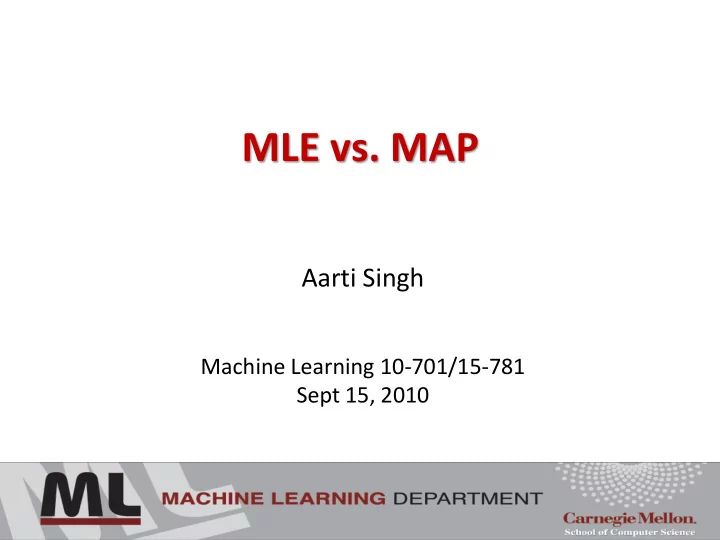

MLE vs. MAP Aarti Singh Machine Learning 10-701/15-781 Sept 15, 2010 1
MLE vs. MAP Maximum Likelihood estimation (MLE) Choose value that maximizes the probability of observed data Maximum a posteriori (MAP) estimation Choose value that is most probable given observed data and prior belief When is MAP same as MLE? 2
MAP using Conjugate Prior Coin flip problem Likelihood is ~ Binomial If prior is Beta distribution, Then posterior is Beta distribution For Binomial, conjugate prior is Beta distribution. 3
MLE vs. MAP What if we toss the coin too few times? • You say: Probability next toss is a head = 0 • Billionaire says: You’re fired! …with prob 1 • Beta prior equivalent to extra coin flips (regularization) • As n → 1 , prior is “forgotten” • But, for small sample size, prior is important! 4
Bayesians vs. Frequentists You are no good when sample is You give a small different answer for different priors 5
What about continuous variables? • Billionaire says: If I am measuring a continuous variable, what can you do for me? • You say: Let me tell you about Gaussians… = N( m , s 2 ) s 2 s 2 6 m =0 m =0
Gaussian distribution Data, D = Sleep hrs 3 4 5 6 7 8 9 • Parameters: m – mean, s 2 - variance • Sleep hrs are i.i.d. : – Independent events – Identically distributed according to Gaussian distribution 7
Properties of Gaussians • affine transformation (multiplying by scalar and adding a constant) – X ~ N ( m , s 2 ) – Y = aX + b ! Y ~ N (a m +b,a 2 s 2 ) • Sum of Gaussians – X ~ N ( m X , s 2 X ) – Y ~ N ( m Y , s 2 Y ) – Z = X+Y ! Z ~ N ( m X + m Y , s 2 X + s 2 Y ) 8
MLE for Gaussian mean and variance 9
MLE for Gaussian mean and variance Note: MLE for the variance of a Gaussian is biased – Expected result of estimation is not true parameter! – Unbiased variance estimator: 10
MAP for Gaussian mean and variance • Conjugate priors – Mean: Gaussian prior – Variance: Wishart Distribution • Prior for mean: = N( h , l 2 ) 11
MAP for Gaussian Mean (Assuming known variance s 2 ) MAP under Gauss-Wishart prior - Homework 12
What you should know… • Learning parametric distributions: form known, parameters unknown – Bernoulli (q, probability of flip) – Gaussian (m, mean and s 2 , variance) • MLE • MAP 13
What loss function are we minimizing? • Learning distributions/densities – Unsupervised learning (know form of P, except q ) • Task: Learn • Experience: D = • Performance: Negative log Likelihood loss 14
Recitation Tomorrow! • Linear Algebra and Matlab • Strongly recommended!! • Place: NSH 1507 (Note: change from last time) • Time: 5-6 pm Leman 15
Bayes Optimal Classifier Aarti Singh Machine Learning 10-701/15-781 Sept 15, 2010
Classification Goal: Sports Science News Features, X Labels, Y Probability of Error 17
Optimal Classification Optimal predictor: (Bayes classifier) Bayes risk • Even the optimal classifier makes mistakes R(f*) > 0 • Optimal classifier depends on unknown distribution 18
Optimal Classifier Bayes Rule: Optimal classifier: Class prior Class conditional density 19
Example Decision Boundaries • Gaussian class conditional densities (1-dimension/feature) Decision Boundary 20
Example Decision Boundaries • Gaussian class conditional densities (2-dimensions/features) Decision Boundary 21
Learning the Optimal Classifier Optimal classifier: Class conditional Class prior density Need to know Prior P(Y = y) for all y Likelihood P(X=x|Y = y) for all x,y 22
Learning the Optimal Classifier Task: Predict whether or not a picnic spot is enjoyable Training Data: X = (X 1 X 2 X 3 … … X d ) Y n rows Lets learn P(Y|X) – how many parameters? Prior: P(Y = y) for all y K-1 if K labels (2 d – 1)K if d binary features Likelihood: P(X=x|Y = y) for all x,y 23
Learning the Optimal Classifier Task: Predict whether or not a picnic spot is enjoyable Training Data: X = (X 1 X 2 X 3 … … X d ) Y n rows Lets learn P(Y|X) – how many parameters? 2 d K – 1 (K classes, d binary features) Need n >> 2 d K – 1 number of training data to learn all parameters 24
Recommend
More recommend